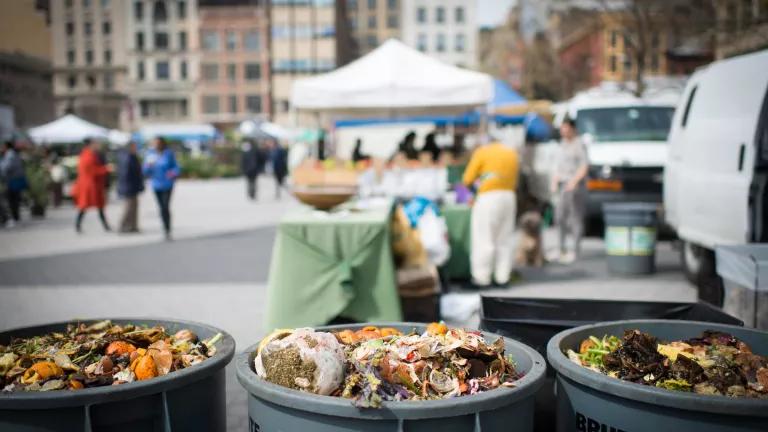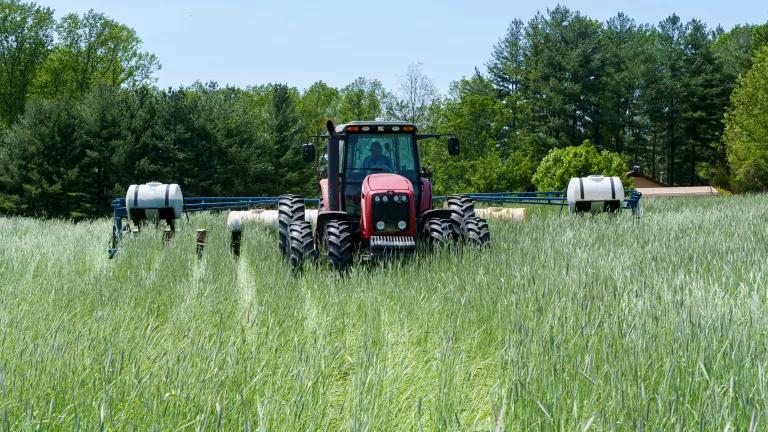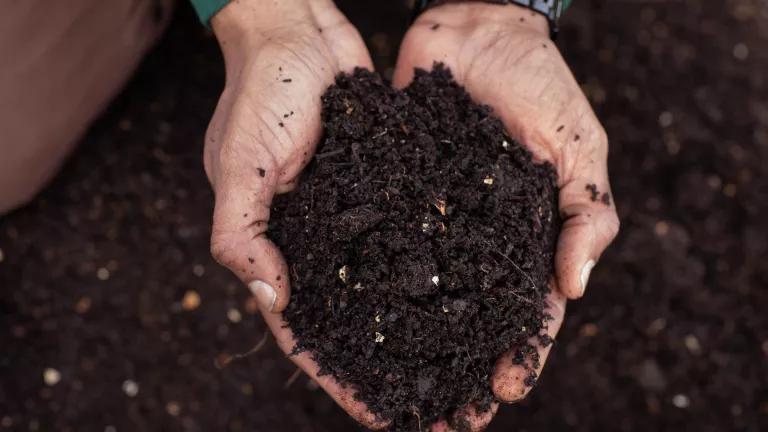City-to-City Learning Exchange Helps Reduce Food Waste
Sharing replicable strategies and lessons learned is critical for wide-scale reduction of food waste. Exchanging knowledge and learnings across cities allows cities to develop and borrow creative solutions to address food waste without recreating the wheel and overburdening staff capacity.

Food scrap collection at an NYC farmers market
Nao Okawa via Flickr
Cities are well-situated to address the enormous amount of food that is wasted. By reducing the amount of food that is thrown out, cities can stabilize their waste management costs and make progress toward climate and sustainability goals. In response to interest by members of USDN (Urban Sustainability Directors Network), NRDC's Food Matters project co-hosted a Food Waste Learning Group for local governments. USDN is a network of municipal government sustainability professionals dedicated to sharing promising practices to build healthier and more sustainable communities, and their mission aligns well with Food Matters’ focus on propagating replicable strategies to reduce food waste.
There is a strong connection between food waste and sustainability. A vast amount of resources and energy go into growing, processing, transporting, and eventually disposing of wasted food. That includes climate-wrecking greenhouse gas emissions at every stage of the food system, plus water, fertilizer, packaging, labor, and more. By reducing and preventing food waste we can prevent these harmful greenhouse gas emissions.
Over the past two years, NRDC and USDN held monthly webinars that typically included 30 attendees each. Highlights from the learning group included:
- Cross-agency collaboration: Breaking down silos between government agencies is critical for successful food waste reduction program implementation. For example, Philadelphia created a working group that sits within their Food Policy Advisory Council and helps to implement strategies associated with the Food Matters project. In building out this group, they found ways to engage a variety of stakeholders, created a leadership structure to share the workload, and developed clear communication channels.
- Household food waste prevention: Households are the largest combined generator of food waste – responsible for 40% of all food waste in the U.S. Cities play a critical role in educating residents to reduce waste. For example, the City of Denver, Action Research, and NRDC have used community based social marketing (CBSM) principles to shape a Denver household habit change project called “Busy People Love Leftovers.” This project explores interventions aimed at reducing household food waste from leftovers and will measure the impact of the interventions over time through residential waste audits. The project is wrapping up in June and we will share the findings in a report.
- Grocery engagement: Excess food from grocery stores is often easiest to donate to food banks and pantries because it is not subject to the additional health and safety requirements of cooked food. For example, nonprofit WRI (World Resources Institute) has developed a global business engagement initiative to increase grocery donations and at the local level, cities like Vancouver are working with grocery stores to help them implement food waste reduction practices.
- Food waste and climate action: Incorporating food waste into climate action plans helps paint a full picture of the GHG emissions that happen in the city and how to best reduce them. Cities should include food waste calculations in their GHG inventories and target ambitious food waste reduction goals in their climate action plans. In Washington DC, as part of their work to address climate change, the city set a goal to reduce food waste by 60% by 2032. In the state of Oregon, to rethink the problem of food waste they shifted from a purely solid waste perspective to a materials management and lifecycle focus and created food waste reduction goals from there.
- Food systems resilience and racial equity: 79% of waste incinerators in the US are located in Black and brown communities. In addition, Black and brown communities are more likely to be in food apartheid areas. Incorporating racial equity is critical to ensuring that any policy or program to reduce food waste will have a positive impact for everyone. Many cities have developed strategies to address and advance racial equity through increasing food access and community composting in Black and brown communities. For example, Baltimore has leveraged community composting as a mechanism to recycle food scraps locally while creating new jobs and promoting local food systems, urban agriculture, and community gardens. The image below is part of Baltimore’s messaging to prevent food waste and create nutrient dense compost.

Designed by Yifan Luo, @yifanluoart
Sharing replicable strategies and lessons learned is critical for wide-scale reduction of food waste. Exchanging knowledge and learnings across cities allows cities to develop and borrow creative solutions to address food waste without recreating the wheel and overburdening staff capacity. Moving forward, NRDC will continue to offer ways to support municipalities on reducing food waste including additional opportunities for knowledge sharing through upcoming webinars, newsletters and more. Please reach out to foodmatters@nrdc.org for more information.





